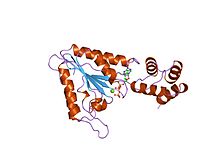| ATPases associated with diverse cellular activities | |||||||||
|---|---|---|---|---|---|---|---|---|---|
 Structure of N-ethylmaleimide-sensitive factor.[1] | |||||||||
| Identifiers | |||||||||
| Symbol | AAA | ||||||||
| Pfam | PF00004 | ||||||||
| Pfam clan | CL0023 | ||||||||
| ECOD | 2004.1.1 | ||||||||
| InterPro | IPR003959 | ||||||||
| PROSITE | PDOC00572 | ||||||||
| SCOP2 | 1nsf / SCOPe / SUPFAM | ||||||||
| CDD | cd00009 | ||||||||
| Membranome | 74 | ||||||||
| |||||||||
AAA (ATPases Associated with diverse cellular Activities) proteins (speak: triple-A ATPases) are a large group of protein family sharing a common conserved module of approximately 230 amino acid residues. This is a large, functionally diverse protein family belonging to the AAA+ protein superfamily of ring-shaped P-loop NTPases, which exert their activity through the energy-dependent remodeling or translocation of macromolecules.[2][3]
AAA proteins couple chemical energy provided by ATP hydrolysis to conformational changes which are transduced into mechanical force exerted on a macromolecular substrate.[4]
AAA proteins are functionally and organizationally diverse, and vary in activity, stability, and mechanism.[4] Members of the AAA family are found in all organisms[5] and they are essential for many cellular functions. They are involved in processes such as DNA replication, protein degradation, membrane fusion, microtubule severing, peroxisome biogenesis, signal transduction and the regulation of gene expression.
- ^ Yu RC, Hanson PI, Jahn R, Brünger AT (September 1998). "Structure of the ATP-dependent oligomerization domain of N-ethylmaleimide sensitive factor complexed with ATP". Nat. Struct. Biol. 5 (9): 803–11. doi:10.1038/1843. PMID 9731775. S2CID 13261575.
- ^ Koonin EV, Aravind L, Leipe DD, Iyer LM (2004). "Evolutionary history and higher order classification of AAA ATPases". J. Struct. Biol. 146 (1–2): 11–31. doi:10.1016/j.jsb.2003.10.010. PMID 15037234.
- ^ Lupas AN, Frickey T (2004). "Phylogenetic analysis of AAA proteins". J. Struct. Biol. 146 (1–2): 2–10. doi:10.1016/j.jsb.2003.11.020. PMID 15037233.
- ^ a b Erzberger JP, Berger JM (2006). "Evolutionary relationships and structural mechanisms of AAA proteins". Annu. Rev. Biophys. Biomol. Struct. 35: 93–114. doi:10.1146/annurev.biophys.35.040405.101933. PMID 16689629.
- ^ Cite error: The named reference
Hanson2005was invoked but never defined (see the help page).